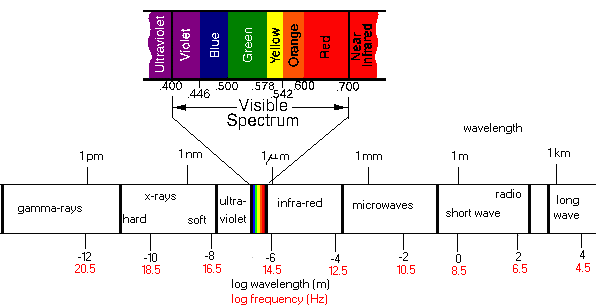A blackbody is an object which absorbs all incident radiations it receives whatever the wavelength or direction and re-emits all these absorbed radiations. An important property of blackbodies is that the re-emitted energy level only depends on the temperature of the blackbody.
For a prescribed temperature and wavelength, no surface can emit more energy than a blackbody.
A blackbody is then an optical reference source, though a theoretical device.
What are the wavelength boundaries of infrared radiation?
The infrared radiation is the electromagnetic radiation where wavelengths are between 700 nanometres and 1 millimetre. Thus, it is located between the red limit of visible spectrum and the shortest microwaves.

However, taking into account the major applications of thermal sensors, the main considered spectral range is between 1 µm and 50 µm including 3 major sub spectral ranges corresponding to the atmosphere transmission windows:
Usual objects are not blackbodies. They do not absorb 100% of the incident energy and usually select the absorbed wavelengths.
Consequently, they cannot re-emit all the incident energy. The ratio between the re-emitted energy of a usual object and the re-emitted energy of a blackbody at the same temperature of the object is called emissivity and noted ε. This ratio depends on wavelength and is comprised between 0 and 1. Of course, the emissivity of a true blackbody equals 1.
However, such bodies do not exist and manufacturing “blackbodies” consists in creating optical sources with emissivity value as high and as constant as possible over the widest spectral range. These sources are called grey bodies but practically sources with emissivity higher than 0.9 are also called blackbodies.
As mentioned in FAQ section, the quantity of energy emitted by a true blackbody only depends on its temperature. This radiation level, named Radiant Emittance R, is defined by the following distribution discovered in 1900 by the German scientist, Max Planck:
Where:
Is it worth learning the Planck law to use a blackbody?
No need for you to learn the Planck’s law by heart!
However it is good to know some important properties of blackbodies as consequences of the Planck’s law:
Example: a blackbody at 800K (i.e. 527°C approx.) emits its maximum radiation at about 3.6 µm, i.e. in the MWIR spectral range.
What are the applications of a blackbody?
As the radiation level of a blackbody only depends on its temperature and is well-known through the Planck’s law, blackbodies are used as optical reference sources for optical sensors. Practically, as the temperatures values for blackbodies emitting over the visible range are very high and as, consequently, this leads to very expensive sources compared to classical lamps, the blackbodies are mainly used over the infrared spectral range starting from 1 µm. That’s why blackbodies are also known as Infrared Reference Sources.
The main applications are of course IR sensors calibration and their specifications measurement.
What types of blackbodies can I find on the market?
Depending on the applications and on the IR sensor range of sensitivity, the manufactured blackbodies are divided into 3 families usually defined by their temperature range:
How can I select the appropriate blackbody for my application?